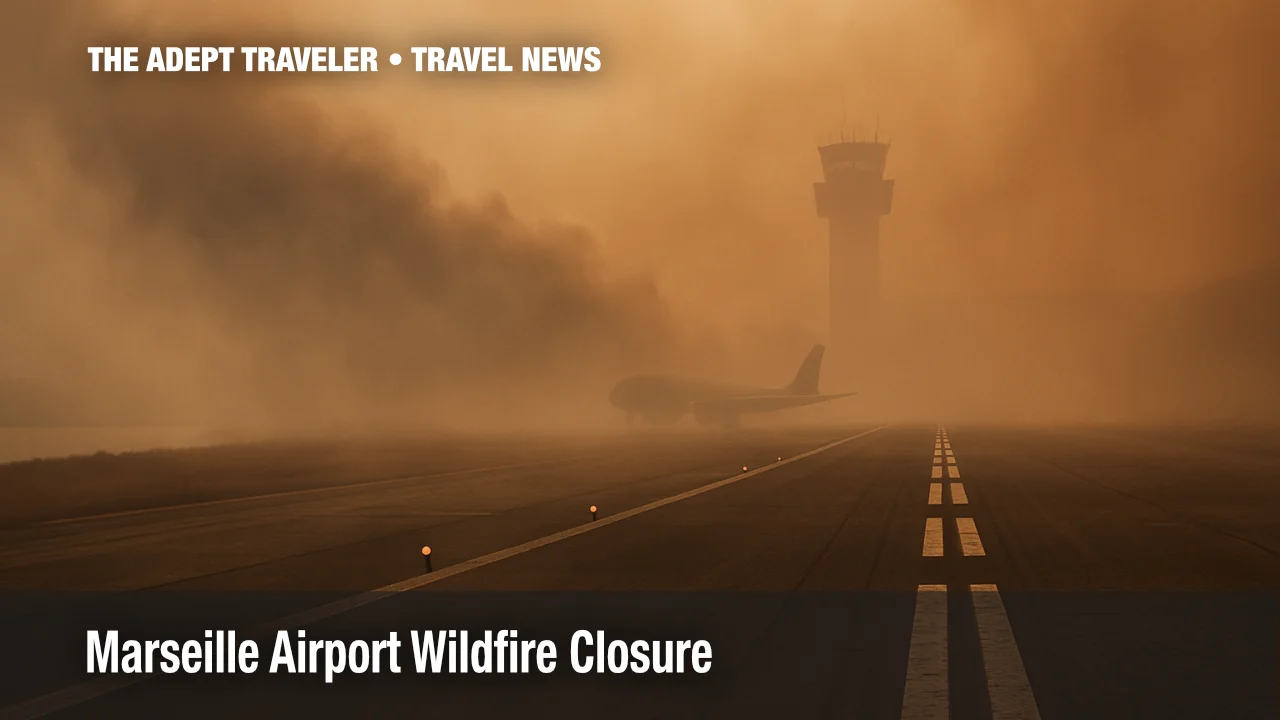Marseille Airport Wildfire Closure: What Travelers Need to Know

A wind-driven wildfire racing through scrubland just north of Marseille forced Marseille Provence Airport (MRS) to shut its single runway around noon local time on July 8, 2025. The Marseille Airport wildfire closure hit as American vacationers flood southern France for peak season, leaving many with last-minute diversions or cancellations. Here's how the shutdown-and the firefighting effort-affects your travel plans.
Key Points
- Runway closed for roughly three hours; gradual reopen now underway.
- Why it matters: MRS is the main entry point to Provence and the Riviera for U.S. travelers.
- Winds reached 43 mph, spreading smoke across flight paths.
- Average departure delay: 166 minutes, per FlightRadar24.
- 168 firefighters, two helicopters deployed; no injuries reported.
Marseille Airport Wildfire Closure Snapshot - How It Works
Marseille Provence Airport sits about 17 miles (27 km) northwest of the city center on the Étang de Berre lagoon. With only one active commercial runway, any runway closure stops all passenger operations. On July 8 officials suspended landings and takeoffs as flames reached Les Pennes-Mirabeau, roughly 5 miles (8 km) away. Aircraft already in the air rerouted to Nice (NCE), Nîmes (FNI), and Lyon (LYS). Once smoke abated, air-traffic control began metering arrivals at reduced capacity, prioritizing long-haul and medical flights. Travelers headed to Provence should prepare for short-notice diversions and build extra ground-transfer time into plans.
Marseille Airport Wildfire Closure Background - Why It Matters
Southern France's Mediterranean climate sees frequent summer wildfires, but prolonged heatwaves-daytime highs topping 93 °F (34 °C) all week-and drought have raised 2025 risk levels. Provence's tourism economy relies on uninterrupted air service; MRS handled 10.4 million passengers in 2024, including nearly 600,000 U.S. arrivals via Paris or other European hubs. Because Marseille lacks redundant runways and sits near flammable garrigue vegetation, even small fires can ground flights. A 2016 blaze closed the airport for six hours and cost carriers an estimated $5 million in compensation and repositioning fees. Tuesday's incident underscores the growing intersection of climate-driven hazards and travel reliability.
Marseille Airport Wildfire Closure Latest Developments
The runway reopened on a limited basis shortly after 3 p.m. local time, but the airport warns of rolling delays throughout the evening.
Runway Status and Flight Options
As of 5 p.m. local, the arrivals board shows 60 percent on-time performance, up from zero at midday. Delta passengers connecting through Paris - CDG can rebook into MRS tomorrow or take the high-speed TGV (about 3 hours). United and American codeshares on Air France are offering free date changes through July 11. If you're already in the air: expect possible diversion to Nice, where SNCF rail links to Marseille run roughly every 30 minutes.
Ground Transportation and Local Advisories
The Bouches-du-Rhône Prefecture urges residents in the 15th and 16th arrondissements to stay indoors, close windows, and keep roads clear for emergency vehicles. Sections of the A7 motorway and the coastal D568 experienced brief closures because of heavy smoke. Regional TER and TGV trains between Marseille and Miramas were suspended for two hours but have resumed with speed restrictions.
Firefighting Efforts and Weather Outlook
Commanders deployed 168 firefighters, 68 engines, and two water-dropping helicopters to contain roughly 74 acres (30 ha). Gusts up to 43 mph (70 km/h) fanned flames, but cooler marine air this evening should lower wind speeds into the mid-teens. Météo-France keeps Bouches-du-Rhône, Var, and Vaucluse under a red wildfire alert-its highest level-through at least Thursday. Travelers should monitor local alerts and limit outdoor activity when smoke is visible.
Analysis
For Americans headed to Provence, the logistical ripple effects can extend well beyond the immediate closure. Transatlantic itineraries often rely on tight intra-Europe connections; a missed Marseille leg may strand you overnight in Paris or Amsterdam. Consider building at least a three-hour layover or booking through airports with multiple runways (Nice or Lyon) during high-fire season. Trip-interruption insurance typically covers wildfire closures, but policies vary-read the fine print on "natural hazard" clauses. Driving from diversion points is feasible: Nice-Marseille is about 125 miles (200 km) via the A8, a two-hour run without traffic. Rail offers a greener backup, but SNCF strikes and speed restrictions can add delays. Finally, Provence's air quality can deteriorate quickly; travelers with respiratory issues should pack N95 masks and use hotel recirculation modes when smoke advisories are in place.
Final Thoughts
Wildfires are now a recurring summer variable in Mediterranean travel. To stay ahead, enroll in your airline's text alerts, download the U.S. State Department's STEP notifications, and bookmark our European Wildfire Travel Tracker for real-time updates. Flexibility-whether in routing, insurance coverage, or ground-transfer plans-remains the best defense against climate-related disruptions. Keep an eye on the Marseille Airport wildfire closure updates, and you'll still arrive in Provence ready to enjoy the calanques and rosé-tinted sunsets.
